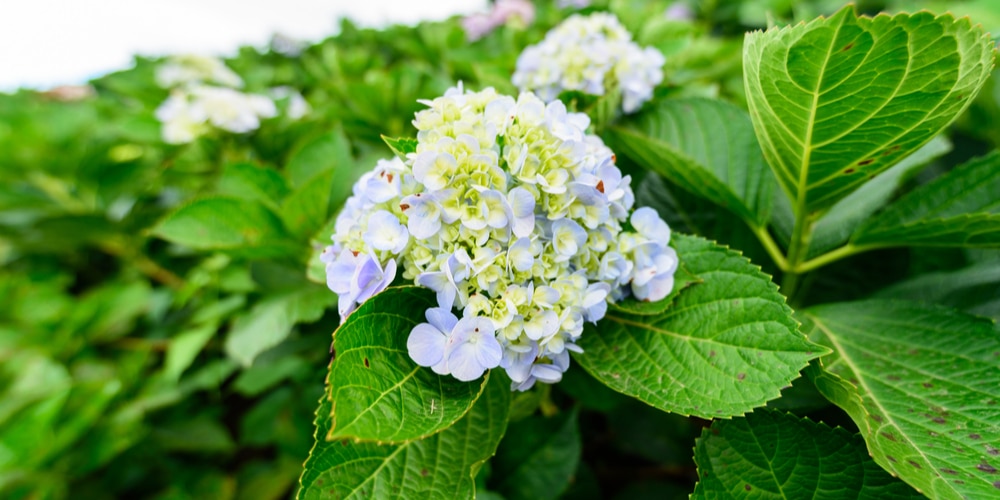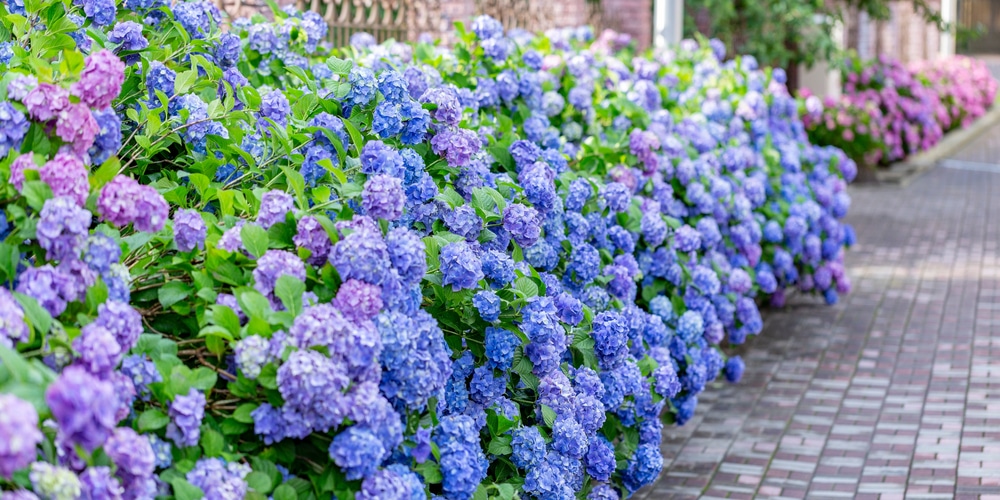‘Early Blue’ Hydrangea Macrophylla boast clusters of flowers that are blue to violet in a spectacular show. The deciduous shrub blooms starting midsummer through early fall.
| Botanical Name | Hydrangea macrophylla |
| Common Name | Bigleaf Hydrangea ‘Early Blue’ |
| Plant Type | Perennial |
| Flower Color | Clusters of violet-blue flowers |
| Size When Mature | 36 to 48 inches |
| Bloom Time | Summer |
| Sun Requirements | Full sun or partial shade |
| USDA Hardiness Zones | 5 to 9 |
| Soil PH Range | 5.0 to 7.0 |
| Soil Type | Moist, rich and well-drained |
| Water Needs | High |
| Native Area | Japan |
What you Need to Know About Early Blue Hydrangea
Hydrangea macrophylla ‘Early Blue’ is a deciduous plant that produces large ball-like groups of striking blue-violet flowers. This hydrangea variety is fairly easy to grow as long as you water them well and keep them in a brightly-lit location.
It’s worth noting that all parts of the hydrangea plant are toxic to pets and humans. Its foliage stays dark green and serves as a nice contrast to the bright blue flowers, which stay blue as long as the plant sits on acidic soil.
How to Care for Early Blue Hydrangea
Here’s everything you need to know about growing and caring for a thriving ‘Early Blue’ Hydrangea
Light
‘Early Blue’ is part of the Bigleaf variety, which means it doesn’t need to be exposed to full sun to grow its best. A location that gets bright, indirect, and natural light should be enough for this hydrangea to grow quickly and produce plentiful blooms atop emerald-green foliage.
Those who live in colder regions can position ‘Early Blue’ to get full sun. For warmer zones, it’s best to put the Bigleaf species in an area that gets morning light and shade in the afternoon. With this in mind, you can plant ‘Early Blue’ in a pot and as a houseplant as long as you put it in a sunny window.
Water and Soil Needs
Hydrangea macrophylla, in general, needs well-drained soil that can hold water. A garden mix amended with organic compost should suffice. Soil pH is important if you want your hydrangea to thrive.
The medium has to have a pH of somewhere between 5.0 to 7.0 so your plant can get nutrients from the soil.
Hydrangeas are known to be voracious drinkers, and ‘Early Blue’ is no exception. The key to watering a hydrangea is to keep the soil relatively moist without it being overly wet or soggy. Deep watering is recommended, where you leave a hose on the plant’s base for 10 to 15 minutes to ensure the hydrangea can get all of its roots wet.
Temperature Requirements
‘Early Blue’ has a USDA zone rating of 5 to 9, which means it can tolerate cold temperatures in these regions fairly well. You may need to provide some form of protection in the event of a hard frost, but the plant is expected to grow new buds in spring.
This hydrangea variety can withstand cold temperatures of up to 5 degrees F, or minus 15 degrees C.
Fertilizer
The best fertilizer to use on an ‘Early Blue’ Hydrangea is a balanced fertilizer, preferably with an NPK ratio of 10-10-10.
Feeding ‘Early Blue’ can be done twice per growing season, with one of them in early spring and the other in summer. Make sure to follow the manufacturer’s instructions on the label to prevent fertilizer burn. The right fertilizing at the right time will boost your hydrangea’s growth and make it produce bigger blooms.
Common Diseases
‘Early Blue’ hydrangeas are not prone to insects and diseases, but the plant might suffer from leaf mold and root rot if the soil is constantly waterlogged.
Leaf issues can be corrected by observing the right watering schedule, while mold and insects can be controlled with a spray of neem oil.
Early Blue Hydrangea Propagation
You can create more Early Blue hydrangea plants using a simple method called stem cutting. With this method, you choose a healthy stem that’s around 4 to 6 inches long, cut it using scissors or garden shears and remove all the leaves except for the ones at the top. You can also reduce the leaves at the top by using a scissor and cutting across them.
Prepare a well-draining medium and stick the cuttings in them. Add water to make the soil moist, then place the container in a brightly lit area. In a few weeks, roots will have formed on the lower leaf nodes. From there, you can repot the cutting and treat it as a new hydrangea plant.
Related Article: Growing Hydrangeas in Zone 10


